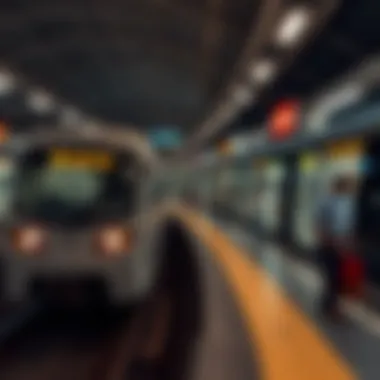Exploring the Gold Card System in Dubai Metro


Intro
Dubai has become a beacon of innovation and efficiency in public transport as it embraces cutting-edge technology and sustainable urban planning. At the heart of this initiative is the Gold Card system utilized by the Dubai Metro. As this city continues to expand and attract both residents and tourists, understanding the Gold Card system is essential. Not just a ticketing solution, the Gold Card is a glimpse into how Dubai is redefining urban mobility.
This unique fare system acts as a smart solution that enhances the commuting experience while offering various benefits for daily travelers. By adopting advanced payment methods and optimizing user experience, the Gold Card fits seamlessly into the fast-paced lifestyle of Dubai's residents.
As the article unfolds, it’ll reveal the intricate details of the Gold Card system, alongside its broader implications on real estate trends and the dynamic transportation landscape of this remarkable city. We'll explore how this innovative system aligns with Dubai's ambitious goals, shaping not only the way people travel but also influencing investment landscapes.
This analysis will offer practical insights tailored specifically for investors, developers, and homeowners eager to navigate this thriving real estate market. In light of these developments, it's crucial to comprehend how transportation solutions like the Gold Card can facilitate not just mobility, but also investment opportunities that arise from them.
With that in mind, let's take a closer look at the evolving property trends within Dubai.
Intro to the Gold Card System
The introduction of the Gold Card system has transformed the way people navigate one of the world's most advanced metro networks in Dubai. This system isn't just about convenience; it's also a reflection of the city’s relentless push towards modernity and efficiency in public transportation. Understanding the Gold Card system offers insights not only into the operational aspects of the Dubai Metro but also into how it intersects with broader economic and urban development goals. For commuters and investors alike, it represents a significant piece of the puzzle that enhances the overall appeal of Dubai’s dynamic transit framework.
Historical Context
To truly grasp the importance of the Gold Card system, one must first consider the historical backdrop of the Dubai Metro. Launched in 2009, the metro was part of a larger vision to ease traffic congestion in a rapidly growing city. Originally designed to cater to the needs of an expanding population and burgeoning tourism, the metro system has seen various enhancements over the years. The Gold Card system, initiated in 2015, further refined the commuting experience, aligning it with the technological advancements and consumer expectations of the present day.
Interestingly, before the Gold Card's advent, residents relied heavily on single-journey tickets and standard Nol cards, which had limitations in flexibility and user-friendliness. The evolution towards the Gold Card signifies not just a shift in ticketing technology but a broader strategy aimed at improving rider convenience and attracting a more diverse range of commuters.
Purpose and Significance
The Gold Card serves multiple purposes, making it an integral component of the Dubai Metro system. Primarily, it is designed to provide easy access to the various metro services while also offering premium features like entry to gold class cabins, which enhances comfort during travel. The significance of the Gold Card goes beyond just a simple fare collection mechanism; it's a nod towards a premium travel experience in a city that values luxury and efficiency.
From a financial perspective, the Gold Card also has significance for budget-minded commuters. It allows for unlimited travel for a limited duration, which can lead to significant savings for regular users. Additionally, it enhances the overall experience by allowing shorter wait times at ticket counters and the added luxury of specialized seating, demonstrating how a simple card can elevate the commuting experience in a city that prides itself on opulence.
Features of the Gold Card
The Gold Card system is a pivotal innovation within the Dubai Metro service, serving as a bridge between modern technology and user-friendly transport solutions. By examining the features of the Gold Card, one can glean not only its practical utility for everyday commuters but also its significance for investors and urban developers. This section details the elements that make the Gold Card a standout within the transport industry and highlights how it enriches the overall commuting experience.
Card Design and Technology
The design of the Gold Card is not just about aesthetics; it blends functionality with a modern look that appeals to a wide demographic. Crafted from durable materials, these cards feature a sleek finish that's both appealing and resilient, catering well to the daily wear and tear expected in a bustling metropolitan environment.
From a technological standpoint, Gold Cards are embedded with advanced RFID (Radio Frequency Identification) technology. This allows for seamless transactions at ticket barriers and vending machines, enhancing the commuter experience. Users simply tap their card against the reader, and within seconds, their fare is deducted. This immediacy is a game-changer, removing the typical hassle of queuing for tickets—a feature that can be a real time-saver during rush hour. Moreover, the cards are compatible with various mobile payment platforms, making travel even more hassle-free.
Pricing Structure
When delving into the pricing structure of the Gold Card, it becomes evident how this system is designed to cater to a diverse user base. The initial purchase fee for a Gold Card is relatively modest compared to conventional transit fares. This aspect ensures that both residents and tourists can easily access this mode of transport without breaking the bank.
To break this down further:
- Standard Gold Card Price: The cost generally hovers around 25 AED.
- Subsequent Recharge Options: Reloading the card is straightforward, with options ranging from 100 AED to 500 AED, depending on user needs.
- Discounts and Promotions: Regular promotional offers, especially for long-term residents and frequent travelers, amplify the affordability.
This pricing strategy not only incentivizes extensive use of the Metro but also supports the overarching goals of Dubai’s public transport framework aimed at efficiency and accessibility.
Top-Up Process
Topping up the Gold Card is intentionally designed to be as user-friendly as the card's initial acquisition. Multiple avenues exist for users to recharge their cards, catering to individual preferences. This flexibility makes it unnecessary to worry about running low on fare while traveling.
Methods of topping up include:


- Automated Machines: Located at every metro station, these machines accept both cash and credit or debit cards.
- Mobile App: The Dubai Metro app allows for easy recharges from the comfort of one’s home. Just link your bank card, and voila—you can add funds in mere moments.
- Customer Service Counters: For those who prefer face-to-face interaction, customer service personnel are available in stations to assist with the topping up process.
Each method provides a layer of convenience—ensuring that users are never caught off guard without enough balance for their next journey.
“The ability to manage your travel funds in ways that suit you best enhances your commuting experience, making transit not just a necessity, but a pleasurable part of daily life.”
In summation, the Gold Card features serve as a cornerstone of the efficient and appealing transport system in Dubai. The integration of thoughtful design, diverse pricing strategies, and flexible top-up options contributes substantially to the overall effectiveness of the Dubai Metro system.
Benefits of Using the Gold Card
The Dubai Metro Gold Card system serves as more than just a ticket; it’s a vital cog in the wheel of urban transport, enhancing the experience for both daily commuters and occasional travelers. The system’s assorted offerings bolster its appeal, making it a smart choice for users who consistently seek convenience, value, and quality in their transit options. Now, let’s delve into the specific advantages that this innovative system has in store, beginning with its everyday utility for passengers.
Convenience for Commuters
Consider the hustle and bustle of everyday life in a thriving metropolis like Dubai. The Gold Card provides a seamless way to navigate through the city's urban sprawl without the hassle of paper tickets or change. One swipe, and you’re in. Facilities like entry and exit gate access streamline the boarding process, allowing individuals to hop on and off at their convenience.
Each Gold Card is designed to fit snugly in a wallet or pocket, which adds another layer of practicality. Even more appealing are the automated top-up stations scattered across metro stations, ensuring that you’ll never find yourself stranded without fare. This accessibility resonates with a wide range of commuters: from the busy professional rushing to a meeting to tourists eager to uncover the wonders of the city.
- Accessibility features: The Gold Card is designed for ease of use, accommodating diverse user groups, including tourists.
- Time-saving benefits: Say goodbye to long queues for ticket purchases, and steer clear of complications associated with cash.
"Many a successful trip starts with the right ticket in hand, and the Gold Card makes that task effortless."
Cost-Effectiveness Analysis
Now, let’s talk numbers. The Gold Card not only simplifies commuting but also presents a financially sound way to travel. Regular users can benefit from discounted fares compared to single-journey tickets. For example, while individual rides might burn a hole in your pocket if taken frequently, the Gold Card offers better rates with each subsequent trip.
- Initial investment: Although there is an upfront cost to acquire the Gold Card, it pays off quickly for those who utilize it consistently.
- Discount tiers: Users often have access to various pricing structures, like monthly or yearly passes, which further reduce travel expenses.
Moreover, imagine being able to accumulate miles or points for local rewards programs due to your travel patterns. It brings that much-needed incentive for commuters who are looking to balance convenience with economy.
Enhancement of Transit Experience
The Gold Card system does more than smooth the user experience; it enriches it. Connectivity is one of Dubai's strong suits, and the Gold Card enhances this interconnectedness.
The integration of the system with various transit modes, such as buses and water taxis, offers a holistic travel approach. With a single card in hand, you can hop between modes without the cumbersome task of fumbling for different tickets.
In addition, the user-friendly mobile app further amplifies this experience by providing real-time data on schedules, routes, and system updates. Commuters can plan their travels efficiently, avoiding potential gaps in service.
To sum it up:
- Unified transit system: Easier transfers and more choices across different modes of transportation.
- Real-time updates: Stay informed and make planning your journey a breeze.
In this way, the Gold Card doesn’t just transport you from point A to B; it elevates the entire journey into a more pleasurable experience, laying the groundwork for a well-designed urban transit framework that benefits everyone.
Integration with Dubai's Urban Planning
The Gold Card system isn’t just about convenience for commuters; it’s intricately woven into Dubai's larger fabric of urban development. The city’s vision emphasizes sustainability and efficient public transport. This innovative payment method aligns well with these goals, encouraging the usage of the Metro while making it a feasible choice for daily commuting.
Sustainable Transportation Initiatives
Dubai is on a transformative journey toward creating a sustainable, eco-friendly transportation network. The Gold Card system plays a pivotal role by facilitating seamless travel across various modes of transport, including metro, buses, and water taxis. By promoting the use of public transit, it helps reduce traffic congestion and carbon footprints. Here are a few points highlighting its impact:
- User-Friendly Interface: The Gold Card’s design simplifies the commuting experience, allowing users to switch between transport modes with ease.
- Incentive Structure: The discounts available on fares with Gold Card usage encourage more people to opt for public transport, thus taking cars off the roads.
- Data-Driven Decisions: The transactions generated through the Gold Card can provide vital data to planners, helping them understand commuting patterns and optimize routes accordingly.


Impact on Property Development
As Dubai expands, the proximity to metro stations has become a significant factor influencing property development. Developers and investors are increasingly recognizing that properties near transit hubs tend to have increased demand.
Proximity to Metro Stations
When looking at urban growth, the closeness to metro stations cannot be overstated. Properties located within a short walk to a metro station enjoy not just heightened interest, but also increased property values. This geographical advantage becomes a key selling point for potential buyers.
- Accessibility: Homeowners appreciate being close to public transit. Properties near metro stations are often rented or sold faster, reducing vacancy rates.
- Urban Attraction: Connecting developments with public transport helps draw in a variety of residents, from young professionals to families seeking an urban lifestyle.
Influence on Real Estate Valuation
The effect of the Gold Card system on real estate valuation is clear. Properties near metro stations typically see a valuation boost due to their convenience and desirability.
- Market Trends: Reports consistently show an uptick in value for properties close to transit options, offering a lucrative opportunity for investors looking for stable long-term gains.
- Established Demand: Buyers and renters are increasingly willing to pay a premium for the added convenience of metro access.
Commercial Opportunities
Lastly, the Gold Card system fosters significant commercial opportunities. Retail outlets, cafes, and service providers situated near metro stations benefit enormously due to high foot traffic.
- Increased Footfall: Businesses can tap into a consistent influx of customers, leading to improved revenue metrics.
- Strategic Locations: Companies frequently choose locations based on their visibility and accessibility via public transport, making properties near stations a hot commodity.
In summary, the integration of the Gold Card system into Dubai's urban planning isn’t just a convenience—it’s a comprehensive strategy that enhances efficiency in transportation, drives property values, and fosters commercial growth in this vibrant city. This is a model worth taking note of for cities around the globe looking to innovate their public transport systems while nurturing sustainable urban development.
Comparative Analysis of Transportation Payment Systems
A comprehensive look into payment systems across various transportation networks gives valuable insights into what makes the Gold Card system in Dubai stand out. It isn’t just about riding a train or making a payment; it��’s about understanding the entire ecosystem of transit and how these systems align with urban development. When evaluating such systems—like the Gold Card alongside others globally—one can appreciate the unique approaches various cities take to achieve efficient movement and financial transactions.
Global Standards
Across the globe, many cities have pioneered innovative payment systems for their mass transit. A standout example is Tokyo's Suica card, which operates not only within the train network but also transcends into payment for shopping and other services. This multifunctionality creates a seamless experience, making it easier for residents and tourists alike. Furthermore, cities such as London with the Oyster card provide similar benefits; users can tap in and out effortlessly, promoting ease of access to public transportation.
- These systems consciously prioritize user experience, minimizing the hassle of purchasing tickets.
- They also promote the adoption of contactless payment technology, embedding itself deeply into daily life.
- Adopting such global standards encourages Dubai's Metro to remain competitive in attracting tourists and business investments, as ease of mobility impacts every urban aspect, from tourism to real estate development.
As the world becomes more interconnected, aligning with global best practices in transportation payment systems can significantly enhance Dubai Metro's appeal. By adhering to these standards, it not only emphasizes efficiency but also positions itself effectively on the global transportation map.
Regional Comparisons
Dubai, while unique in its own right, benefits from monitoring and evaluating the payment systems adopted by its regional counterparts. For instance, places like Riyadh and Abu Dhabi have embarked on ambitious public transportation projects, and the payment systems they employ can provide useful insights. The concept of unified transit cards is being adopted, ensuring users can switch from buses to trains without breaking stride.
- In Riyadh, the system incorporates advanced technology for ease of use, potentially mirroring features of the Gold Card system in terms of user-friendly interfaces.
- Meanwhile, Abu Dhabi has recently rolled out integration between bus and tram systems, similar to how Dubai is positioning its Gold Card to facilitate seamless travel.
Such comparisons showcase how Dubai’s Metro can optimize its Gold Card structure, primarily focusing on regional trends. Not only does this make travel easier, but it aligns with ongoing urban development plans, enhancing the attractiveness of the surrounding real estate markets.
The integration of advanced payment systems in public transport is a prerequisite for cities aspiring to develop as global hubs. It is not merely a technological upgrade but a fundamental enhancement of urban life.
Challenges and Criticisms
The Gold Card System within the Dubai Metro, while innovative, is not free from scrutiny. Understanding the challenges and criticisms associated with it is vital for investors, commuters, and urban planners alike. As the system continues to evolve, addressing these challenges can enhance its effectiveness and further align it with Dubai's vision for sustainable transport.
User Accessibility
One of the primary concerns surrounding the Gold Card System is user accessibility. While the system is designed to streamline the travel experience, there are segments of the population who find it less accommodating. For instance, elderly users or tourists unfamiliar with technology might struggle with the card management process. Despite the automated systems in place, the reliance on technology can alienate those less tech-savvy, potentially leading to frustration.
Moreover, language barriers could impede understanding of the system's guidelines and top-up procedures. Localizing information could help ease this issue.
As a solution, interactive kiosks could offer multilingual support and user-friendly interfaces, making it easier for everyone to access the metro services.


Technology Limitations
The technology behind the Gold Card System, although cutting-edge, has its limitations. Instances of malfunctions at ticket validators or top-up machines can cause undue delays and may discourage users from opting for Metro services altogether. These technical hiccups can lead to an overall negative perception of the public transport system.
Moreover, the reliance on smartphone apps for managing the Gold Card creates accessibility issues in areas with limited internet connectivity. Not everyone has access to smartphones or reliable mobile data plans, making it essential to have alternative methods for managing the card.
Keeping technology user-centric, by incorporating feedback from regular users, allows for continuous improvement.
Public Perception
The public perception of the Gold Card System is another crucial aspect to consider. Many commuters are concerned about the perceived high initial price of the card, which could deter potential users despite the long-term savings it offers. Some view it as a privilege for the affluent, potentially limiting its widespread acceptance.
Additionally, the effectiveness of public awareness campaigns plays a key role in shaping opinions. If the benefits and functionalities of the Gold Card are not adequately communicated, skepticism may lead potential users to hold onto traditional payment methods.
Consistent engagement through community outreach, social media platforms, and informational campaigns can help shed light on real user experiences, promoting a more favorable view of the Gold Card System.
"The Gold Card is not merely a travel tool; it should be seen as an essential part of Dubai’s urban fabric. Ensuring its accessibility and public acceptance is crucial to achieving a genuinely integrated transport solution."
As the Gold Card System emerges further, addressing these challenges will not only help retain existing users but attract new ones, enhancing the overall efficacy of Dubai’s public transport landscape.
Future Development Opportunities
The Gold Card system, while already enhancing the Dubai Metro experience, also opens doors to several future development opportunities. As urban landscapes evolve, so too does the need for transportation systems to adopt innovative solutions that align with growth forecasts. Properly leveraging these opportunities not only benefits commuters but can also significantly impact real estate values and investment prospects. Let's delve deeper into this multifaceted topic, focusing on emerging technologies and expansion plans.
Emerging Technologies
Technology is an ever-shifting landscape, and to stay relevant, the Gold Card system must embrace ongoing technological advancements. One potential direction includes integrating blockchain technology. Imagine a network where transactions are not only efficient but also highly secure, eliminating concerns about data breaches. Using blockchain could revolutionize the way fares are managed, providing transparency and reducing fraudulent activities.
Moreover, smart card technology could further enhance user experience. These cards could be embedded with features such as contactless payment and mobile applications that allow for instant top-ups or even a live balance check. As mobile usage continues to soar, this shift could position Dubai Metro as a leader in adopting cutting-edge technology in public transport.
In addition, the implementation of AI-driven analytics can help identify commuter trends and patterns. This data can be monumental for transit planners. It offers the potential to adjust schedules based on the high-demand periods, ultimately leading to a better commute experience. With timely data at their disposal, planners can efficiently allocate resources where needed.
Expansion Plans for Metro Services
As Dubai continues to develop, so does the vision for expanding its Metro services. The current metro network already covers a significant area; however, proposed routes aim to serve additional districts and nearby suburbs. This can improve commuter access and reduce congestion, especially in newly developed areas. As real estate projects spring up in these regions, integrated metro stops can substantially heighten property values.
The expansion of the metro system may also include upgrades to existing lines, such as increased train frequencies and enhanced facilities at stations. Improvements like Wi-Fi access and comfortable waiting areas can make commuting far more pleasant. These upgrades will not only make the Metro more user-friendly but will also bolster the overall allure of living near these stations. With every added stop, the potential for development springs up, making properties nearby highly desirable.
"The integration of metro services with urban planning is crucial for addressing future transport needs of a rapidly growing population."
Real estate investors can take advantage of this by identifying properties in proximity to proposed expansion projects. The earlier they position themselves in emerging areas, the greater the return on investment they stand to gain as demand for housing in those communities skyrockets.
In summary, the future of the Gold Card system and the Metro’s expansion holds promising opportunities. Emerging technologies and these expansion plans serve as a blueprint for sustainable growth in Dubai’s urban environment. They not only aim to address the immediate needs of commuters but also present long-term benefits for investors looking to capitalize on the evolving market.
Culmination
The analysis of the Gold Card System illuminates its vital role within the broader context of the Dubai Metro service. By dissecting the intricacies of the card’s features and its benefits, one can grasp its significance in shaping commuter experiences. A seamless transit experience is paramount in a city like Dubai, where mobility is intricately linked to both lifestyle and economic dynamism.
Through the lens of this article, we see that the Gold Card does more than facilitate travel; it fosters a culture of convenience that aligns with Dubai's ambitious urban development plans. The focus on integrating advanced technology not only enhances daily commuting but also cultivates a sense of community among its users.
Summary of Insights
The Gold Card System stands out due to its unique blend of functionality and user-centered design. Highlights from this exploration include:
- Ease of Use: The card streamlines the payment process, enabling passengers to hop on and off without the fuss of cash transactions.
- Financial Benefits: Frequent users benefit from discounted fares, making it an economical choice for daily travelers.
- Technological Integration: The card's design incorporates RFID technology, ensuring swift access to services and improving the overall efficiency of the Metro.
Moreover, the Gold Card is a key element backing Dubai's transport infrastructure and its overarching vision for sustainable living.
Implications for Real Estate Investment
Understanding the Gold Card System's implications for real estate investment reveals several layers of opportunity:
- Desirability of Locations: Properties near metro stations often see increased demand, as proximity to transit options becomes a critical factor in buyers' preferences.
- Value Appreciation: Areas well-served by the Metro, particularly those with access to the Gold Card system, experience notable increases in property valuation.
- Commercial Opportunities: Businesses located close to metro stations can benefit from heightened foot traffic, thanks to the ease of access provided by the Gold Card.
As the city grows, the symbiosis between transport infrastructure and real estate development will likely redefine opportunities for all stakeholders involved.
For additional information, consider exploring resources on urban transport systems available at Wikipedia or insights on real estate trends at Britannica and forums like Reddit.















